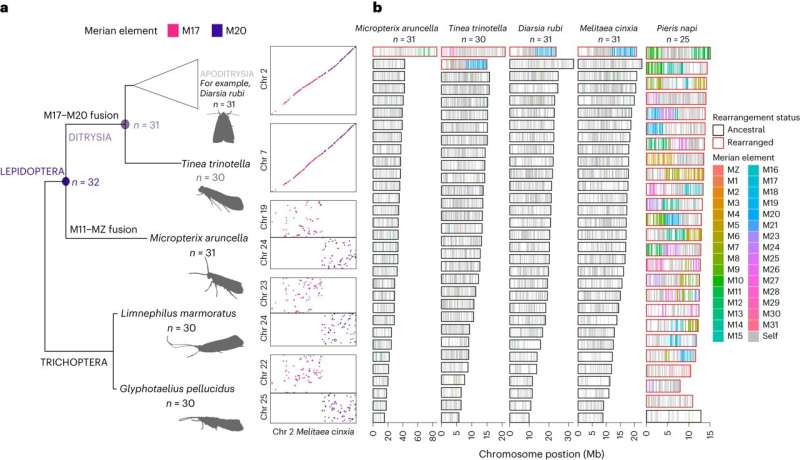This article has been reviewed according to Science X's editorial process and policies. Editors have highlighted the following attributes while ensuring the content's credibility:
fact-checked
trusted source
proofread
Analysis shows butterfly and moth genomes are mostly unchanged despite 250 million years of evolution

The most extensive analysis of its kind reveals how butterfly and moth chromosomes have remained largely unchanged since their last common ancestor over 250 million years ago. This stability exists despite the incredible diversity seen today in wing patterns, sizes, and caterpillar forms across over 160,000 species globally.
Researchers from the Wellcome Sanger Institute and their collaborators at the University of Edinburgh analyzed and compared over 200 high-quality chromosome-level genomes across butterflies and moths to better understand their evolutionary history.
They further uncovered rare groups of species that broke these genetic norms and underwent genetic rearrangements, including chromosome fusions—where two chromosomes merge—and fissions—where a chromosome splits.
The findings, published in Nature Ecology and Evolution, shed light on the tight constraints governing genome evolution in these ecologically vital insects. They also offer insights into factors that have enabled select species to defy these rules of evolution. These insights can inform and enhance conservation efforts by guiding targeted strategies, monitoring ecosystem health, adapting to climate change, and incorporating genetic information into broader conservation initiatives.
The work is part of the Darwin Tree of Life Project, aiming to sequence all 70,000 species in Britain and Ireland, and contributes to the larger Earth BioGenome Project to sequence all 1.6 million named species on Earth.
The study raises broader questions about how chromosomal changes shape biodiversity over time. The researchers will continue focused efforts to sequence all 11,000 European butterfly and moth species as part of the newly launched Project Psyche.
Butterflies and moths—collectively called Lepidoptera—represent 10% of all described animal species and are hugely important pollinators and herbivores in many ecosystems.
In this new study, researchers from the Wellcome Sanger Institute and their collaborators set out to understand the processes that drive the evolution of chromosomes of this highly diverse group.
They identified 32 ancestral chromosome building blocks, named "Merian elements" after the pioneering 17th century entomologist Maria Sibylla Merian, that have stayed intact across most butterfly and moth species since their last common ancestor over 250 million years ago.
With the exception of a single ancient fusion event between two chromosomes that led to the 31 chromosomes seen in most species today, chromosomes of most current species directly correspond to these ancestral Merian elements. The team found not only were chromosomes incredibly stable, but the order of genes within them was too.
The team found some species with minor changes, mainly involving fusions of small autosomes and the sex chromosome. This highlights the role of chromosome length as a driver of evolutionary change.
However, researchers uncovered a rare subset of species such as the blue butterflies—Lysandra—and the group containing cabbage white butterflies—Pieris—that have defied these genome structure constraints. These groups underwent extensive chromosome reshuffling, including breakage of chromosomes, and large scale reshuffling through fission and fusion.
The work increases understanding of factors that lead to genetic diversity within these insects. This can guide efforts to protect and preserve specific species facing unique challenges and environmental changes tied to climate change.
Charlotte Wright, first author of the study at the Wellcome Sanger Institute, said, "The chromosomes of most butterflies and moths living today can be traced directly back to the 32 ancestral Merian elements that were present 250 million years ago. It is striking that despite species diversifying extensively, their chromosomes have remained remarkably intact."
"This challenges the idea that stable chromosomes may limit species diversification. Indeed, this feature might be a base for building diversity. We hope to find clues in rare groups that have evaded these rules."
Professor Mark Blaxter, senior author of the study and Head of the Tree of Life program at the Wellcome Sanger Institute, said, "Studies like this, which allow us to delve into these evolutionary processes, are only possible with initiatives like the Darwin Tree of Life project generating high-quality, publicly available genome assemblies. We are amplifying these efforts in Project Psyche, aiming to sequence all 11,000 butterfly and moth species in Europe with collaborators across the continent."
"As vital pollinators, herbivores, and food sources of various ecosystems, as well as powerful indicators of ecosystem health, a deeper understanding of butterfly and moth biology through Project Psyche will inform future studies on adaptation and speciation for biodiversity conservation."
More information: Charlotte J. Wright et al, Comparative genomics reveals the dynamics of chromosome evolution in Lepidoptera, Nature Ecology & Evolution (2024). DOI: 10.1038/s41559-024-02329-4
Provided by Wellcome Trust Sanger Institute




















